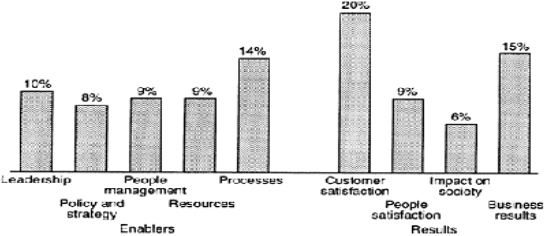SKEDSOFT
Introduction:
The model for the European Quality Award includes the whole company and all elements of the new management pyramid (the TQM pyramid). The European Foundation for Quality Management (EFQM) initiated this Award. This yearly award is recognized as the most successful exponent of TQM in Europe for that particular year. It appears that the model consists of nine elements grouped in two halves, one of which comprises the enablers of the company and the other the results.
THE MODEL:

Fig: Model for the European Quality Award
· It appears that the model consists of nine elements grouped in two halves, one of which comprises the enablers of the company and the other the results.
· The interesting thing about the model is the fact that it comprises both the enablers and the results.
· Through ISO 9000 many European companies have gradually become acquainted with the assessment of parts of the enablers of quality management and of course they are also familiar with the assessment of parts of the results (the business results).
· However, there is no tradition that the two areas are assessed as a whole and in the same detail as shown here.
· Furthermore, it is interesting that an exact weight is stated for each single element of the model.
· These weights can of course be discussed and may be changed as time goes by.
· The assessment reflects the general perception of what characterizes leading TQM companies.
Criterion 1: Leadership
How the behaviour and actions of the executive team and all other leaders inspire, support and promote a culture of Total Quality Management.
Criterion 2: Policy and strategy
How the organization formulates, deploys, reviews and turns policy and strategy into plans and actions.
Criterion 3: People management
How the organization releases the full potential of its people.
Criterion 4: Resources
How the organization manages resources effectively and efficiently.
Criterion 5: Processes
How the organization identifies, manages reviews and improves its processes.
Criterion 6: Customer satisfaction
What the organization is achieving in relation to the satisfaction of its external customers.
Criterion 7: People satisfaction
What the organization is achieving in relation to the satisfaction of its people.
Criterion 8: Impact on society
What the organization is achieving in satisfying the needs and the expectations of the perception of the organization’s approach to quality of life, the environment and the preservation of global resources, and the organization’s own internal measures of effectiveness. It will include its relations with authorities and bodies which affect and regulate its business.
Criterion 9: Business resultsWhatthe organization is achieving in relation to its planned business objectives and in satisfying the needs and expectations of everyone with a financial interest or other stake in the organization.